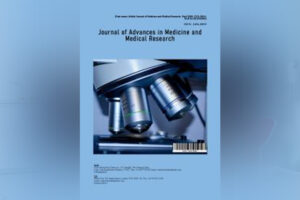Journal of Advances in Medicine and Medical Research
Volume 35, Issue 16, Page 78-84, 2023; Article no.JAMMR.100852 ISSN: 2456-8899
(Past name: British Journal of Medicine and Medical Research, Past ISSN: 2231-0614, NLM ID: 101570965)
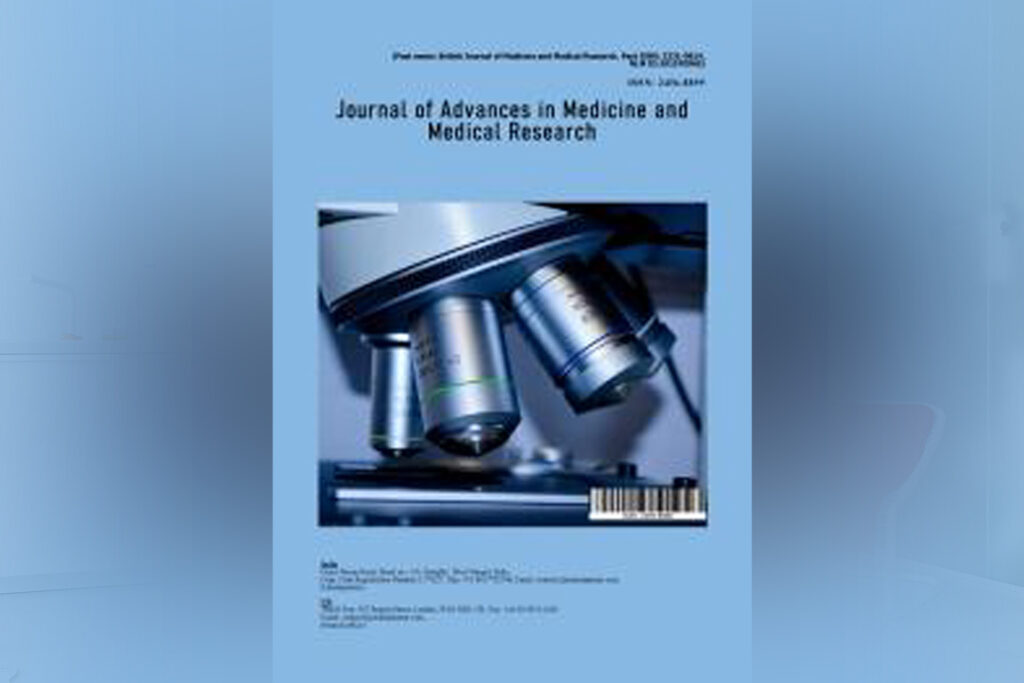
Can We Improve Clinical Outcomes and Patient Engagement after TKA Using a Digital Health Remote Monitoring Platform? Perioperative Results with Recupe
Timothy Hui a*, Subu Subramanian a and Atul Kamath b
a Plethy, USA.
b Cleveland Clinic, USA.
Authors’ contributions
This work was carried out in collaboration among all authors. All authors read and approved the final manuscript.
Article Information
DOI: 10.9734/JAMMR/2023/v35i165091
Open Peer Review History:
This journal follows the Advanced Open Peer Review policy. Identity of the Reviewers, Editor(s) and additional Reviewers, peer review comments, different versions of the manuscript, comments of the editors, etc are available here:
https://www.sdiarticle5.com/review-history/100852
Received: 10/04/2023
Accepted: 13/06/2023
Published: 21/06/2023
ABSTRACT
Background: In their recovery plan, total knee arthroplasty (TKA) patients generally receive outpatient physical therapy and a home exercise plan. However, in the past home exercise plan compliance was not able to be tracked. With the advent of digital health, such as Plethy’s Recupe mobile app, home exercise plans can now be measured, providing compliance data along with exercise specific data.
Methods: Out of 245 TKA patients on Recupe, 53 patients were selected who performed exercises both pre-op and post-op, and also stayed on their program for at least 40 days and had a minimum of 50% engagement.
Results: Pain decreased significantly from pre-op (3.6/10) and 1st week (4.28/10) post op to 1 month post-op (2.65/10). Knee Flexion ROM increased significantly from the 1st week post op (44.72) to 1 month Post op (58.13). This was the range of motion performed during home exercises, not the max measurement from a healthcare provider.
Patients engaged the app 5.6 times per week. Previous research showed non-compliance at up to 70%.
Conclusions: This study suggests that digital health can help keep patients engaged in their home exercises. Those who adopt it show excellent engagement. This will likely lead to improved pain and ROM compared to those without digital health, who are not likely to comply with their prescribed home exercise plan.
1. INTRODUCTION
Total Knee Arthroplasty (TKA) is a commonly performed joint replacement surgery to treat degenerative knee joints. After this surgery, exercises and physical therapy are commonly prescribed to ensure full recovery [1]. Though outpatient physical therapy is supervised, much of the recovery time is unsupervised and performed at home [2]. Unfortunately, studies have shown that non-compliance of these home exercises can be up to 70% [3]. This non-compliance can lead to complications such as decreased knee flexion and disability, leading to additional procedures, such as manipulation under anesthesia and joint revisions [4,5].
To prevent these complications, and to catch early infections [6], doctors examine patients, looking at a number of key areas. Knee flexion range of motion (ROM) is one of these key areas for TKA. A previous study demonstrated 27% knee flexion ROM gains after two weeks, and 50% at the beginning of 6 weeks for patients receiving medical treatments [7].
Pain is another key metric, as pain is one of the biggest determining factors to the quality of someone’s life [8].
Especially when chronic, pain can also lead to psychological changes that then lead to disability [9]. A previous study on TKA found that pain averaged 3.68 on a 1-10 scale at one month, with 44% of the patients reporting 4/10 pain or more. These patients had received both inpatient and outpatient physical therapy [10].
Post-operative rehabilitation addresses ROM and pain and leads to other benefits such as reduced hospitalization and follow-up services, lower complications, and improved quality of life. [11,12]. Rehabilitation exercises can also be prescribed pre-operatively, called pre-habilitation, where studies show benefits with anxiety, less hospitalization, and improved outcomes overall [13-16]. Research also has shown improved recovery from TKA [17,18].
However, all of this relies on the patient performing their rehabilitation. One solution for this problem is remote monitoring of these therapeutic exercises. Recupe is a mobile app which guides patients through exercises while monitoring with a wearable device. Coaches also train and motivate the patients. It is used in addition to physical therapy to improve compliance and performance of home exercises. Studies have shown that exercises such as these are as effective as those done with in-person supervision [19,20]. Data on mood and motivation during sessions was also recorded on the app. Previous studies, including those done with Recupe, have shown decreased adherence with depressed moods [21-23].
For this retrospective study, we observed the recovery of patients after a TKA while using Recupe in addition to their normal medical and physical therapy visits. This includes pain, ROM, adherence, and mood. This created normative data for TKA patients engaged with digital health.
2. METHODS AND PROCEDURES
We identified 245 patients who underwent a TKA between July 2021 and May 2022. We filtered out patients who had adherence less than three times a week, adherence defined as any activity. 172 total patients were identified. We then applied the following filters:
Duration less than 40 days
Engagement less than 50% of days
73 patients were identified. The next filter was to eliminate all patients who did not perform pre-op exercises, that is before their surgery. This eliminated 20 patients, leaving 53 patients for this study.
2.1 Demographics
In our population, the average age is 68.43 (SD 7.75)
Male – 51%
Female – 49%
All of the patients were group health patients from Orthopedic clinics.
2.2 Intervention
The intervention used here is the Recupe app and wearable sensor, created by Plethy. This allows for pain and range of motion measurement with patient engagement, along with various patient information such as red flag symptoms, mood, motivation and support. This is used for remote patient monitoring for both surgical and non-surgical diagnoses, and also pre-operative exercises. Real time feedback is given to patients and health care providers.
With this, home exercise programs (HEP) from doctors and physical therapists can be recorded as they are performed. Coaches train patients in use of the app and for weekly encouragement and follow up. Patients also attended doctor and physical therapy visits as usual for TKA.
3. RESULTS
Pain: Pain was measured using a Numerical Pain Rating Scale (NPRS) of 0-10.
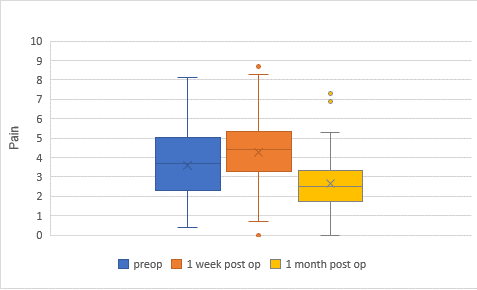
Pre op – Average pain 3.6/10 (SD 1.79)
First week Post op – Average pain 4.28/10 (SD 1.86)
1 month Post op – Average pain 2.65/10 (SD 1.51)
P-Values
Pre-Op vs First week – .060
Pre-Op vs 1 Month Post op – .000028
First week vs 1 Month Post-op – .000005
So changes are statistically significant at 1 month post-operative versus both pre-op and first week pain values.
Knee Flexion ROM:
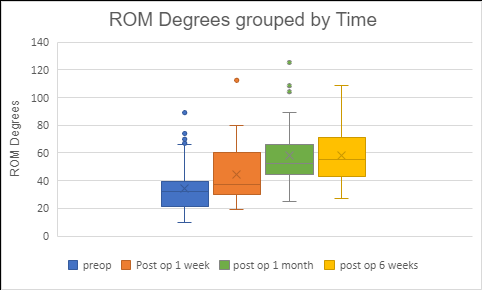
Pre-op – 34.51 (SD 18.60)
First week Post op – 44.72 (SD 20.29)
1 month Post op – 58.13 (SD 21.11)
6 weeks Post-op – 57.79 (SD 19.31)
P-Values
Pre-op vs first week – 1.66 E-10
Pre-op vs 1 month post-op – .000021
First week vs 1 month post-op – .0017
First week vs 6 week post op – .0014
Changes from pre-op and first week ROM to both 1 month and 6 month post-op are all statistically significant.
Patient Engagement:
Average patient engagement was 5.6 days/week (SD – 1.19). Engagement was defined as any exercise or pain report or other activity.
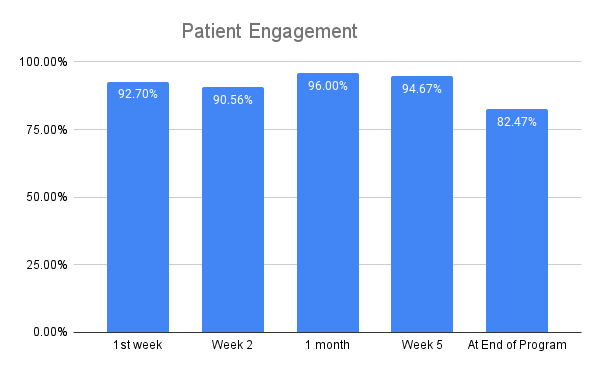
Engagement
1st week – 92.70% (SD 15.75%)
Week 2 – 90.56% (SD 17.93%)
Month 1 – 96.00% (SD 19.60%)
Week 5 – 94.67% (SD 13.08%)
End of program – 82.47% (SD 23.88%)
Average duration of program for patients was 18.67 weeks (End of program). Patients averaged 4.5 treatment days per week on their last week.
4. DISCUSSION
Patient selection – Although many patients were referred to Recupe for care, since it was not structured as a mandatory program, patients tended to drop in the first few weeks. Thus, the fitering selected those patients where Recupe was a continuous factor in their rehabilitation.
Pain – Pain was highest in the first week, then improved substantially. After one month, Recupe patients have an average pain of 2.65, less than what was shown in previous research [10] which found an average of 3.68 achieved with the use of inpatient and outpatient PT. Recupe patients did not have any inpatient PT, which is costly, so, Recupe patients recovered to lower pain levels with fewer patient visits and health care utilization.
Recupe patients demonstrated a statistically significant 30% improvement in knee ROM in 1 month with only exercise. However, this is the ROM increase for exercises performed at home, not the maximum ROM in a clinical setting, which is how previous research measured knee flexion ROM. Further research is required to examine the relationship between ROM performed during home exercises and maximum ROM measured by a healthcare professional. A previous study measured ROM progression after TKA with patients receiving outpatient physical therapy and found 25% knee flexion improvement in the first month. Kittelson et al. [24], similar results to those from this study.
Recupe utilizes a patient’s own mobile device and only uses an inexpensive sensor., which makes monthly costs approximately equal to 1 or 2 sessions of physical therapy. So, use of Recupe for pre-op and post-op therapy results in recovery metrics that compare well to previous research with substantially less therapy and cost.
Engagement – Recupe patients demonstrate excellent engagement. Patients engagement on Recupe stands at 81.8% at the end of week 2, tailing off only to 72.38% by the end of the program. Average patient engagement is 4.23 days/week. Previous studies have shown engagement rates (to prescribed at-home rehab exercises) as low as 30% [4]. This improved engagement may explain much of the pain and ROM benefits from Recupe. The actual exercises performed are likely the same, however patients will only benefit when they exercise.
Therefore, digital health, such as Recupe, can enable patients to stay engaged at much higher rates than observed previously, thus resulting in faster recovery and lower costs.
The main weakness of this study is the lack of a control group for comparison, leaving all comparisons to be performed against published information. Thus, this is a descriptive study of current information to create normative data. Also, this population consisted of patients who adopted digital health, not those who refused or who rarely used it. However, healthcare providers may be able to use non-compliance of digital health as a risk factor for patients developing complications or a delayed recovery.
Future studies will consist of A/B comparisons performed at the same clinic with a Recupe group and a Non-Recupe group. This may better show the benefits of digital health.
5. CONCLUSION
Digital health can help keep patients engaged in their home exercises. Those who adopted it demonstrated excellent engagement. These patients also experienced good recovery. Digital health users may also show improved pain and ROM compared to those without digital health, who are not likely to comply with their prescribed home exercise plan. The difference is likely the improved adherence to these prescribed exercises.
ETHICAL APPROVAL
As per international standard or university standard written ethical approval has been collected and preserved by the author(s).
CONSENT
As per international standard or university standard, patient(s) written consent has been collected and preserved by the author(s).
COMPETING INTERESTS
Study IRB approval and Conflict of Interest review have been completed through BRANY. The Principal Investigator/lead author is an employee of Plethy.


